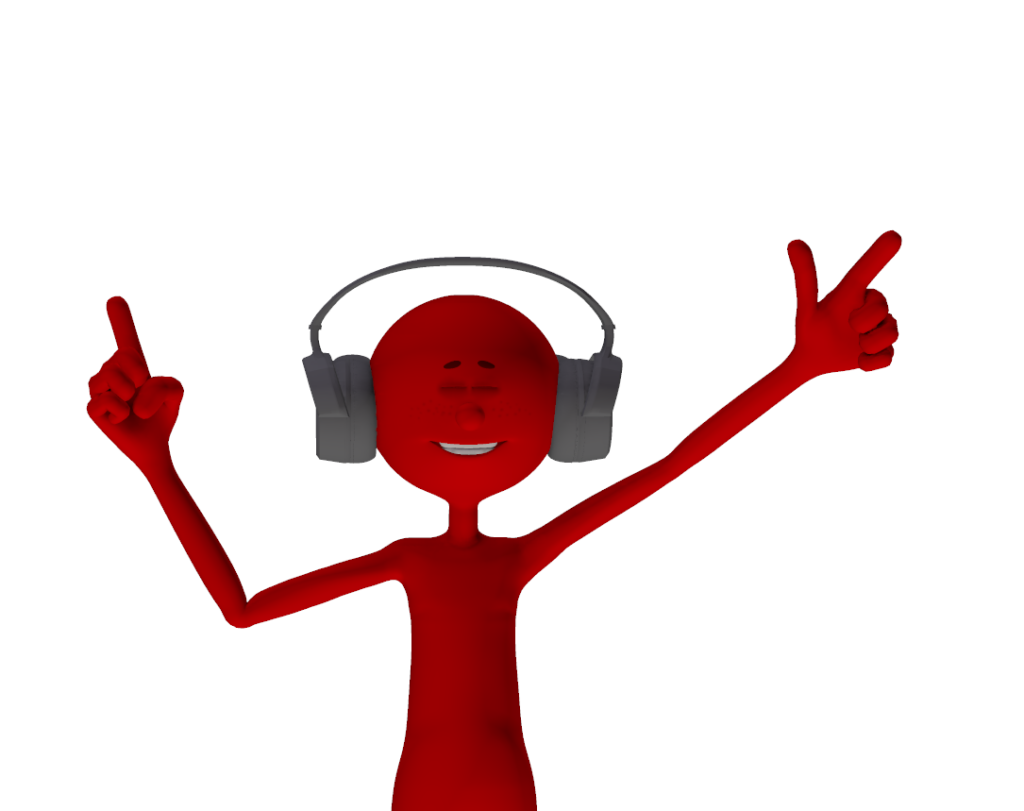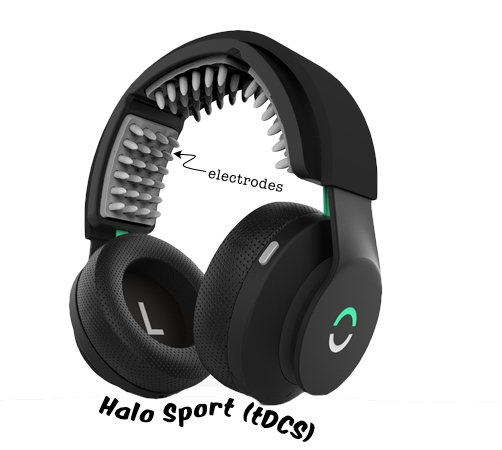Stimulating the brain. Literally!
937 words; estimated reading time 4 mins, 41 secs.
Stimulate your mind
I find the whole gimmick culture that plagues sport, exercise, and health absolutely fascinating. The thought processes and craftiness of the people who think up, and market these things is as intriguing as the vulnerability and gullibility of the people putting their money and trust in their products. Deep down I have to think that the gimmick entrepreneurs fully understand the wishful thinking that characterises their customers, and boy do they take advantage of that knowledge!
The gimmick product
A couple of years back I was searching for a product to review in lectures and came across a product called the ’Halo Sport’ – it even had pictures of NFL players using it – couldn’t be more perfect for my intended purpose. Only USD$399 (on sale for $299 this week) for a stylish looking gadget that promises to give you “better results, faster“. Their website suggests that this means faster and more effective skill learning and more resistance to fatigue with strength and endurance performances. The Halo Sport is backed by 4,000 plus peer-reviewed papers – well so they say!
The ‘sciencieness’

The Halo Sport (and similar gadgets) uses a technology known as Transcranial Direct Current Stimulation (tDCS). The idea is that tDCS applies a weak direct current (non-invasively) to the scalp through surface electrodes. The aim is to modulate (regulate/adjust) the excitability of targeted brain regions. Noninvasive brain-stimulation techniques have been adopted from experimental studies that were conducted with clinical populations, where brain stimulation was used to treat specific neurological conditions such as depression and schizophrenia (Finkenzeller et al, 2018).
Application to sport
While those studies had clear clinical objectives and targeted specific areas of the brain, non-clinical applications seem to be a bit ‘messier’. We know that the determinants of sports performance are exceptionally complex. We are also aware that there are multiple regions of the brain that control, limit or regulate the different systems and muscle groups associated with exercise (Machado et al, 2019a). My blog on fatigue (see fatigue blog) described the debate around central and peripheral aspects of fatigue. Park et al (2019) suggest that muscle fatigue occurs when the primary motor cortex (M1) is unable to generate signals, and when there are feedback/signals from peripheral fatigue factors. In commercial settings tDCS aims to stimulate the M1 area and increase the excitability of that region. This, in turn, may help in delaying the fall in neural drive to muscles (Machado et al, 2019a). There are also claims that tDCS will blunt pain sensations and improve motor unit recruitment (Park et al, 2019).

Reality check time
While that may all make compelling theoretical sense, if we perform a bit of a stocktake (see research blog) there would appear to be some fundamental flaws. For example, how could a commercial headset accurately target a specific area of each individual’s brain and deliver an appropriate current through variable layers of hair, skin, skull and brain membranes? There have been two recent systematic reviews of the technology (Halgado et al, 2019a; Machado et al, 2019b), both noting a variety of outcomes from some poorly designed studies (their words). Halgado et al (2019a) concluded that any benefit from tDCS is likely small and likely influenced by publication and reporting biases. Similarly, Machado et al (2019b) found that the evidence was weak and noted that only three studies had employed the intervention with actual athletes. Given that elite athletes are suggested to be better able to resist fatigue signals anyway, extrapolating an effect from untrained participants is going to be a reach.
The evidence is mixed at best
Although the Halo website boasts 4,000 plus scientific articles, only 36 were listed on their site and only two of those used the Halo device specifically – most of the remainder involved lab-based versions of tDCS. One paper (Park et al, 2019) had participants running on a treadmill at a speed equivalent to 80% of their VO2max. They found that those that received Halo tDCS ran for about 15% longer than those receiving sham stimulation. However, closer inspection of the study indicates that there were only 12 relatively untrained participants with high-performance variability between individuals. Furthermore, they were completing a task that had minimal relevance to sports performance. A second paper (Huang et al, 2019) employed a similar design (sham vs real) using 5 x 6s sprints on a cycle ergometer, finding that the Halo Sport significantly improved mean power output during cycling sprints. Again the nine participants in this study were untrained.
Recent studies have however failed to replicate those positive results. Valenzuela et al (2019) claim that there is little support for the effectiveness of tDCS at enhancing endurance performance in elite athletes. Their study found that tDCS did not improve 800m swimming performance in elite triathletes, although the tDCS resulted in the participants feeling more energetic and lively before and after the test. Holgado et al (2019) exposed male trained cyclists and triathletes to sham-controlled tDCS, finding that it did not affect exercise performance. Seidel & Ragert (2019) found that tDCS did not help athletes or non-athletes with performing speed-related tasks. So for athletes, there does not seem to be any worthwhile benefit.
The take home
In summary, tDCS appears to be another one of those intriguing ideas that have been rushed to market without appropriate testing, and without really understanding the intricacies of sports performance and training. One review (Edwards et al, 2017) even talked of tDCS being an unfair advantage – more like taking advantage! Individual variability and the complex interaction between the mind and the body is going to require technological breakthroughs to work much, much harder than that! It seems that commercial models of tDCS are unlikely to override fatigue signals, drive greater recruitment of muscles, or speed up skill learning. I know, I know – Some of you are going to say what if tDCS actually does work? What if it does give you that extra 1% for performance? My answer as always – put more professional thought and effort into the other 99% first. So let’s keep training and being creative for now. Meanwhile I’ll continue to wear my halo – its a really good look for me.
Best, Phil
Selected references
- Edwards, D.J., Cortes, M., Wortman-Jutt, S., et al (2017) Transcranial Direct Current Stimulation and Sports Performance. Front. Hum. Neurosci. 11:243. doi: 10.3389/fnhum.2017.0024
- Finkenzeller, T., Würth, S., Amesberger, G. (2018) Consumer- Grade Brain Stimulation Devices in Sports: A Challenge for Traditional Sport Psychology?, Journal of Applied Sport Psychology, 30:4, 473-493.
- Halo Sport website https://www.haloneuro.com accessed 25 Jul 2019.
- Holgado, D., Vadillo, M.A., Sanabria, D. (2019a) The effects of transcranial direct current stimulation on objective and subjective indexes of exercise performance: A systematic review and meta-analysis. Brain Stimulation 12;242-250.
- Holgado D., Zandonai, T., Ciria, L.F. et al (2019b) Transcranial direct current stimulation (tDCS) over the left prefrontal cortex does not affect time-trial self-paced cycling performance: Evidence from oscillatory brain activity and power output. PLoS ONE 14(2): e0210873. https://doi.org/10.1371/journal. pone.0210873
- Huang, L., Deng, Y., Zheng, X. et al (2019) Transcranial Direct Current Stimulation With Halo Sport Enhances Repeated Sprint Cycling and Cognitive Performance. Front. Physiol. 10:118. doi: 10.3389/fphys.2019.00118
- Machado, D.G., Unal, G., Andrade, S.M. et al (2019a) Effect of transcranial direct current stimulation on exercise performance: A systematic review and meta-analysis. Brain Stimulation 12; 593-605.
- Machado, D.G., Unal, G., Andrade, S.M. et al (2019b) Effect of transcranial direct current stimulation on exercise performance: A systematic review and meta-analysis. Brain Stimulation 12; 593-605.
- Park, S.-B., Sung, D.J., Kim, B. et al (2019) Transcranial Direct Current Stimulation of motor cortex enhances running performance. PLoS ONE 14(2): e0211902. https://doi.org/ 10.1371/journal.pone.0211902
- Seidel, O., Ragert, P. (2019) Effects of Transcranial Direct Current Stimulation of Primary Motor Cortex on Reaction Time and Tapping Performance: A Comparison Between Athletes and Non-athletes. Front. Hum. Neurosci. 13:103. doi: 10.3389/fnhum.2019.00103
- Valenzuela, P.L., Amo, C., Sánchez-Martínez, G. et al (2019) Enhancement of Mood but not Performance in Elite Athletes With Transcranial Direct-Current Stimulation International Journal of Sports Physiology and Performance 14; 310-316.
